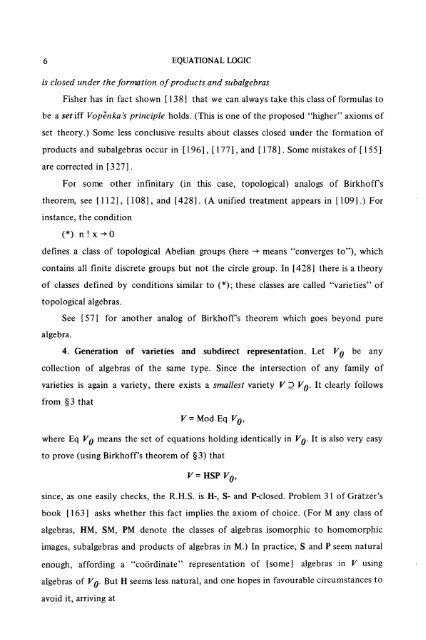Survey 1979: Equational Logic - Department of Mathematics ...
Survey 1979: Equational Logic - Department of Mathematics ...
Survey 1979: Equational Logic - Department of Mathematics ...
You also want an ePaper? Increase the reach of your titles
YUMPU automatically turns print PDFs into web optimized ePapers that Google loves.
6 EQUATIONAL LOGIC<br />
is closed under the formation <strong>of</strong> products and subalgebras.<br />
Fisher has in fact shown [ 138] that we can always take this class <strong>of</strong> formulas to<br />
be a setill Vopnkag principle holds. (This is one <strong>of</strong> the proposed "higher" axioms <strong>of</strong><br />
set theory.) Some less conclusive results about classes closed under the formation <strong>of</strong><br />
products and subalgebras occur in [196], [ 177], and [ 178]. Some mistakes <strong>of</strong> [ 155]<br />
are corrected in [327].<br />
For some other infinitary (in this case, topological) analogs <strong>of</strong> Birkh<strong>of</strong>f"s<br />
theorem, see [ 112], [108], and [428]. (A unified treatment appears in [ 109] .) For<br />
instance, the condition<br />
(*) n ! x 0<br />
defines a class <strong>of</strong> topological Abelian groups (here means "converges to"), which<br />
contains all finite discrete groups but not the circle group. In [428] there is a theory<br />
<strong>of</strong> classes defined by conditions similar to (*); these classes are called "varieties" <strong>of</strong><br />
topological algebras.<br />
algebra.<br />
See [57] for another analog <strong>of</strong> Birkh<strong>of</strong>f's theorem which goes beyond pure<br />
4. Generation <strong>of</strong> varieties and subdirect representation. Let V 0 be any<br />
collection <strong>of</strong> algebras <strong>of</strong> the same type. Since the intersection <strong>of</strong> any family <strong>of</strong><br />
varieties is again a variety, there exists a smallest variety I,' D_ V 0. It clearly follows<br />
from õ3 that<br />
I,' = Mod Eq V 0,<br />
where Eq V 0 means the set <strong>of</strong> equations holding identically in V 0. It is also very easy<br />
to prove (using Birkh<strong>of</strong>f's theorem <strong>of</strong> õ 3) that<br />
V = HSP<br />
since, as one easily checks, the R.H.S. is H-, S- and P-closed. Problem 31 <strong>of</strong> Gnitzer's<br />
book [ 163] asks whether this fact implies the axiom <strong>of</strong> choice. (For M any class <strong>of</strong><br />
algebras, HM, SM, PM denote the classes <strong>of</strong> algebras isomorphic to homomorphic<br />
images, subalgebras and products <strong>of</strong> algebras in M.) In practice, S and P seem natural<br />
enough, affording a "co6rdinate" representation <strong>of</strong> [some] algebras in V using<br />
algebras <strong>of</strong> V 0. But H seems less natural, and one hopes in favourable circumstances to<br />
avoid it, arriving at

















